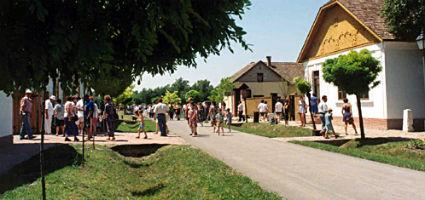2024. November 22. Friday
Ópusztaszer National Historic Memorial Park - Ópusztaszer
 |
Address: 6767, Ópusztaszer Szoborkert 68.
Phone number: (62) 275-133 /103, (62) 275-133 /104
E-mail: info@opusztaszer.hu
Opening hours: 01.04-30-10.: Tue-Sun 10-18
01.11-30.03.: Tue-Sun 10-16 (Skanzen, external exhibiton closed) The current fare for those interested informed about the institution's website: www.opusztaszer.hu |
The village hall was the headquarters of the delegates and leadership. Usually it was built in the middle of the village, close to the church. The village hall of Tömörkény built in 1895-96 was moved over to the open air collection. The eclectic building was partly built in the Classicist style characteristic at the end of the 19th century. By this building, the skanzen has a more county town quality.
On the walls of the corridor, an exhibition of the history of public administration is displayed. Next, we enter the office of the judge of the village. The judge, usually a wealthy farmer, was the president of the delegates. The furniture of his room is a reminder of the 1920-30's. Besides this the room of the revenue office of the village, in the third room the objects of public administration are shown.
In the other wing of the building, the post office and the history of post can be seen. It is a rare display since it recalls the atmosphere in which the wife of a village post officer lived. The officer women took care of their homes besides working. Their lives were similar to that of the teachers.
The 'red post coach' is displayed in the shed in the garden of the village hall.
On the walls of the corridor, an exhibition of the history of public administration is displayed. Next, we enter the office of the judge of the village. The judge, usually a wealthy farmer, was the president of the delegates. The furniture of his room is a reminder of the 1920-30's. Besides this the room of the revenue office of the village, in the third room the objects of public administration are shown.
In the other wing of the building, the post office and the history of post can be seen. It is a rare display since it recalls the atmosphere in which the wife of a village post officer lived. The officer women took care of their homes besides working. Their lives were similar to that of the teachers.
The 'red post coach' is displayed in the shed in the garden of the village hall.